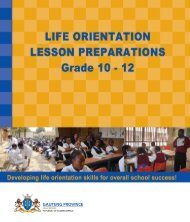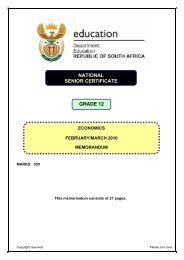Life Science Grade 11
Life Science Grade 11
Life Science Grade 11
You also want an ePaper? Increase the reach of your titles
YUMPU automatically turns print PDFs into web optimized ePapers that Google loves.
<strong>Grade</strong> <strong>11</strong> <strong>Life</strong> <strong>Science</strong>s Lesson PlansGRADE <strong>11</strong> SUBJECT <strong>Life</strong> <strong>Science</strong>s WEEKWeek 2TOPIC Protists LESSON 1LESSON SUMMARY FOR: DATE STARTED:LESSON OBJECTIVESDATE COMPLETED:Content:PROTISTSBasic structure and general characteristics:• Using charts, electron-micrographs etc; to describe the structure of protists• List general characteristics of protistsThe learners will be able to:• Explain the structure of protists: classifying them as plant like, animal - like or fungus- like.• List the general characteristics of protists.TEACHER ACTIVITIES LEARNER ACTIVITIES TIMING RESOURCES NEEDED1. Whole class discussion, group work.1.1 Introduction• The protists are considered to be in a kingdom on their own.• Learners need to understand where the bacteria, and protists fit into the classification of livingorganisms and that protists are a very diverse group• Remind learners what the meaning of eukaryotic and prokaryotic• (If available, allow learners to examine microscope slides of different protists)10 min• Prepared microscopeslides showing differentprotists2.2 Main Body (Lesson presentation)• Explain to the learners that the kingdom Protista consists of a very diverse groups of unicellular(single celled), eukaryotic organisms (nucleus and organelles are bound by membranes).• Have learners write down the following in their workbooks:• Most of the protists respire aerobically.• They reproduce either asexually or sexually.• Protists are classified into 3 groups: animal- like (heterotrophic) and move, plant- like (autotrophic)and fungus- like (saprophytic).• Protozoans are single-celled organisms and are surrounded by a permeable cell membrane thatcontrols what substances may enter and exit the cell• Some use pseudopodia (projections or extensions from the cell that change shape) for locomotion(amoeba) while others have cilia (hair- like projections)or flagella (long projections that move likea whip)• Algae are single-celled or multi-cellular organisms that are plant-like since they canphotosynthesise• Have learners draw a labelled diagram of a protist (amoeba)• Learners should complete questions on the protists in their workbook2.3 Conclusion• Most organisms may be placed into categories easily E.g. plant or animal.• However, some organisms don’t fit into specific categories and feeding characteristics may help• Learners to write downthe generalcharacteristics ofprotists.• Learners draw alabelled diagram of theamoeba and completequestions on protists intheir workbook15 min15min5 min• Solutions for all <strong>Life</strong><strong>Science</strong>s <strong>Grade</strong> <strong>11</strong>pp.10 - <strong>11</strong>• Oxford Successful <strong>Life</strong><strong>Science</strong>s <strong>Grade</strong> <strong>11</strong> pp.16• Solutions for all <strong>Life</strong><strong>Science</strong>s <strong>Grade</strong> <strong>11</strong> ,classroom activity 3pp. <strong>11</strong>• Oxford Successful <strong>Life</strong><strong>Science</strong>s <strong>Grade</strong> <strong>11</strong>Activity pp. 17,Term 1 Page 9© Gauteng Department of Education (CAPS version)







